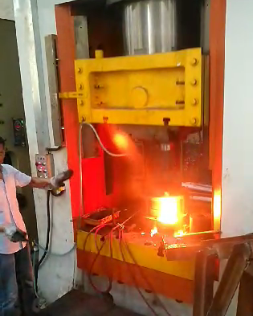Under forging temperature, the deformation resistance of high strength aluminum alloy is larger than steel, and the external friction factor is larger, so the fluidity of aluminum alloy is poor.Therefore, the forging of aluminum alloy has its own technological characteristics, as follows:
I. Blank preparation
The raw materials for forging are cast ingots, rolled blanks and extruded blanks. Most aluminum alloy forgings are made of extruded blanks. For the billets of large die forgings, when the size of extruded bar is not enough, the forged billets of cast ingots forged by forging press are used as billets.
2. Heating before forging
Heating aluminum alloy blank, because forging temperature range is very narrow, it is best to use a heating element with heat insulation screen, air forced circulation and automatic temperature control box type resistance furnace. Before loading the furnace, the blank should remove oil and other dirt. No steel blank should be retained in the furnace, so as to avoid the explosion caused by the mixing of aluminum chips. In order to ensure that the aluminum alloy will not crack during forging, the maximum allowable deformation of each blow or compression on the selected forging equipment should be determined according to the alloy's plastic diagram.
3,The deformation speed has no great influence on the process plasticity of most aluminum alloys. In addition, when the deformation velocity changes from low to high, the deformation resistance varies with the alloying degree of the alloy. In order to increase the allowable deformation degree and improve the production efficiency, reduce the deformation resistance and improve the fluidity of the mold cavity of the alloy filling mold, the aluminum alloy forging machine selects forging press is better than the forging hammer. Therefore, aluminum alloy is most suitable for forging on the low-speed forging press.
4,Lubrication during die forging
Mould lubrication is one of the key factors of aluminum alloy forging process. Both the lubricant itself and the lubrication operating system are the main technical issues and development focus of mold lubrication. The main component of lubricant for aluminum alloy forging is usually graphite, and some organic or inorganic compounds can be added in colloidal suspension to obtain better results. The carrier of lubricant can be mineral oil or water. Graphite particles embedded in the surface of forgings can cause stains, pits and corrosion, so the surface must be cleaned after forging with a forging press.
5,cleaning and repair
Due to the soft quality of aluminum alloy, poor fluidity, and strong adhesion to the mold, forgings are prone to fold, crack, peeling and other defects. If these defects are not cleaned in time, the forging will continue to develop again, resulting in scrap of forgings. Therefore, the cleaning and repairing of the intermediate process of aluminum alloy forging and die forging plays an important role in the process of aluminum alloy forging. The cleaning procedure of forgings is as follows: after die forging, remove the burr edge from the band saw or edge cutting die, and the forgings after cutting edge are hoisted into the erosion washing tank for cleaning.
